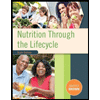
Concept explainers
To state: The type of diet that Person D had originally adopted.
Introduction: Adolescents, especially those involved in the extra-curricular activities, usually find it difficult to devote time to healthy meals. Due to this reason, they are more prone to meal skipping, snacking, and eating food that costs less and is quicker to eat. Snacking can be included in dietary plans to complement meals, but adolescents usually replace regular meals by a less-energy giving, dense, and less nutritional snack items.
Explanation of Solution
Person D is 18-years old pursuing a dual degree in business and environmental studies. He lives in a campus that offers a 12-meal-per-week meal plan. He skips breakfast and replaces that meal with a high-calorie coffee. Person D mostly takes lunch and dinner at the cafeteria in his residence hall, but the nutritional composition he had focused on were that of higher calories. He rarely had a salad bar or a sandwich bar. On weekends, he usually replaces two meals with a brunch and had several snacks throughout the day. Person D has a mini-fridge that remains stuffed with various fluid beverages that he used to complement to his diet. He also has a microwave in his shared room. Person D had interest in animal welfare and joined a group that inculcates sustainable food practices and can impact feedlots in terms of climate change. After two months of his undergraduate education, he decided to become a strict vegetarian. This was in an attempt to limit the sources of animal proteins and that resulted in a visible weight loss for Person D.
Person D is an adolescent who eats away from home because he is pursuing his undergraduate education in a state university. He seldom had a breakfast and relied more on food that was quick to eat. His breakfast was mostly coffee, and his other meals consisted of food that was cooked in microwave in excess oil. The diet adopted should have increased his body weight and decreased the wellness of Person D.
To state: The type of diet that Person D is currently consuming.
Introduction: Adolescents, especially those involved in the extra-curricular activities, usually find it difficult to devote time to healthy meals. Due to this reason, they are more prone to meal skipping, snacking, and eating food that costs less and is quicker to eat. Snacking can be included in dietary plans to complement meals, but adolescents usually replace regular meals by a less-energy giving, dense, and less nutritional snack items.
Explanation of Solution
Person D is 18-years old pursuing a dual degree in business and environmental studies. He lives in a campus that offers a 12-meal-per-week meal plan. He skips breakfast and replaces that meal with a high-calorie coffee. Person D mostly takes lunch and dinner at the cafeteria in his residence hall, but the nutritional composition he had focused on were that of higher calories. He rarely had a salad bar or a sandwich bar. On weekends, he usually replaces two meals with a brunch and had several snacks throughout the day. Person D has a mini-fridge that remains stuffed with various fluid beverages that he used to complement to his diet. He also has a microwave in his shared room. Person D had interest in animal welfare and joined a group that inculcates sustainable food practices and can impact feedlots in terms of climate change. After two months of his undergraduate education, he decided to become a strict vegetarian. This was in an attempt to limit the sources of animal proteins and that resulted in a visible weight loss for Person D.
Person D has adopted a strict vegetarian diet since the time he joined the animal welfare group. His current diet had eliminated him from consuming proteins from red meat, poultry, fish, eggs, milk, and also high carbohydrate content food. The vegetarian diet provided him high amount of fibers, vitamins, iron, and micronutrients. The current consumption is also free from excess fat and protein. Though the protein intake has decreased tremendously, the wellness quotient of Person D has increased, and he can involve actively in animal welfare group exercises. The immediate and visible effect of the current diet plan is Person D’s weight loss, which makes him look healthier.
Want to see more full solutions like this?
Chapter 14 Solutions
Nutrition Through The Life Cycle
 Nutrition Through The Life CycleHealth & NutritionISBN:9781337919333Author:Brown, Judith E.Publisher:Cengage Learning,
Nutrition Through The Life CycleHealth & NutritionISBN:9781337919333Author:Brown, Judith E.Publisher:Cengage Learning, Nutrition Through the Life Cycle (MindTap Course ...Health & NutritionISBN:9781305628007Author:Judith E. BrownPublisher:Cengage Learning
Nutrition Through the Life Cycle (MindTap Course ...Health & NutritionISBN:9781305628007Author:Judith E. BrownPublisher:Cengage Learning





